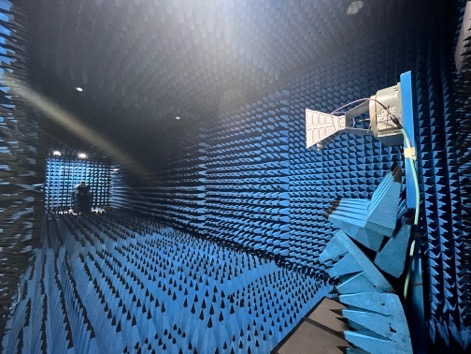Introduction

In today’s hyper-connected world, flawless wireless performance isn’t optional – it’s expected. RF testing serves as the invisible backbone of every successful deployment of wireless devices, ensuring optimal performance, regulatory compliance and real-world reliability. As technologies like 5G, Wi-Fi 6E/7 and IoT push boundaries, comprehensive RF testing has become the difference between market leaders and costly failures. This blog explores the importance of RF testing, key methodologies, advanced tools and emerging trends, providing a comprehensive overview of how RF testing shapes the future of wireless communication.

Why RF Testing Matters
RF testing is indispensable for several reasons. First, it validates the performance of antennas and RF circuits, ensuring they operate at the desired frequencies, output power, receiver sensitivity, antenna gain and radiation patterns etc. Without proper testing, any unintentional issues or flaws in the device design or its operation may go unnoticed and consequently can lead to the product suffering from poor signal strength, dropped connections or inefficient power usage. Second, RF testing ensures compliance with global regulatory standards such as FCC and CE, which govern emissions and interference levels. Non-compliance can lead to costly redesigns or even product recalls.
Beyond performance and compliance, RF testing simulates real-world conditions to assess how devices behave in diverse environments. For example, MIMO (Multiple Input Multiple Output) systems, beamforming antennas and multi-band devices must be tested for signal integrity, interference and coexistence with other wireless technologies. RF testing also plays a critical role in identifying and mitigating issues like impedance mismatches (measured via VSWR or Return Loss) and undesired inter radio/chain signal leakage or crosstalk and antenna isolation problems.
In industries like automotive, healthcare and industrial IoT, where wireless reliability is mission-critical, RF testing ensures that devices function flawlessly under all conditions.
Key RF Testing Methodologies
1. RF Circuit Level Testing (Conducted Mode)
Listed below are a few fundamental RF Circuit or PCB level tests which are essential to perform to ensure adequate and acceptable RF performance.
Return Loss or VSWR: Return loss measures how much of the outgoing RF signal is reflected back to the source due to impedance mismatches encountered in the RF path. Its unit is dB, with higher values (or more negative values if sign is considered) indicating better impedance matching and hence better performance. Return loss is essentially part of what are known as S-parameter measurements, denoted by S11 and S22. VSWR also quantifies the impedance mismatch in the RF path in form of ratio (unitless), with the ideal value of 1:1 meaning no signal reflection. Isolation checking between two radios or two chains is also an important metric especially when there’s a possibility of signal leakage from one RF chain (transmitter/aggressor) to the adjacent chain (receiver/victim), which can severely degrade RF performance.
Chain Gain: This is the total amplification a RF signal will experience in its path before reaching the Antenna (for transmitting signal) or the Transceiver (for the receiving signal). Like Return loss, this is also a S Parameter Measurement, denoted by S21 (port 1 denoting input and port 2 denoting output) and unit is dB. (For a passive network, S12 will be the same as S21, but the same is not true for networks including active components where this indicates reverse isolation.)
Both Return Loss (S11, S22) and Chain Gain (S21) are measured using VNA (Vector Network Analyser). Engineers connect the Starting and ending points of the concerned RF network or whole chain to the input and output ports of the VNA respectively (usually UFL, SMA, etc.) to the VNA, set the frequency range (e.g., 5G’s n78 band or Wi-Fi 7’s 6 GHz spectrum) and analyze the results. This provides insights into possible impedance tuning that can be performed to optimise the RF performance.
Output Power: This is the total conducted mode TX Power the RF signal will attain just before reaching the antenna port. Its unit is dBm (logarithmic) or Watt (linear). This is measured with the help of VSA (Vector Spectrum Analyser), which analyses the Output RF signal and VSG (Vector Signal Generator), which generates and feeds the input RF signal to the device under test. This provides the measure of how much RF power our device is going to generate and deliver to the antenna before being radiated out. This is an important metric, as meeting the device output power is a crucial requirement. Other than output power, VSA can measure other important parameters like EVM, ACLR, etc as well, which helps evaluate the output signal quality.
Receiver Sensitivity: This is the primary evaluation performed in the receiver chain and denotes the minimum RF signal power level which can be reliably detected and decoded by the Transceiver and hence the device.
2. Gain and Radiation Pattern Measurement
Gain and radiation pattern testing evaluates how effectively an antenna directs signal strength in specific directions. Peak gain, measured in dBi, indicates the maximum radiation intensity, while beamwidth defines the angular range where the antenna performs optimally. For directional antennas, the front-to-back ratio is also measured to assess unwanted rearward radiation.
These tests are performed in an anechoic chamber, which eliminates external reflections. A reference horn antenna transmits a signal, while the device under test (DUT) rotates 360 degrees at precise intervals. By comparing the received power between the reference antenna and the DUT, engineers calculate gain and map radiation patterns.
3. Polarization Testing
Polarization testing determines the orientation of an antenna’s electric field, which is critical for applications like GPS, satellite communication and radar. The axial ratio—a measure of polarization purity—helps classify antennas as circularly polarized (0–3 dB), elliptically polarized (>3 dB) or linearly polarized (>20 dB).
To conduct this test, the antenna is rotated in co-polarized and cross-polarized planes and the gain difference is recorded. This data ensures that the antenna meets the requirements for its intended use, such as maintaining signal integrity in GPS trackers or automotive radar systems.
4. Active Radiated Power and MIMO Testing
Active radiated power (TRP) and total isotropic sensitivity (TIS) testing evaluate real-world performance in multi-antenna systems like Wi-Fi 7 routers or 5G devices. TRP measures the total power emitted by the device, while TIS assesses receiver sensitivity.
For MIMO and beamforming systems, specialized testers simulate multi-path fading, phase delays and interference scenarios. This ensures that devices with multiple antennas (e.g., 12 antennas in a Wi-Fi 7 router) operate efficiently without signal degradation.
Advanced RF Testing Tools
Modern RF testing relies on cutting-edge equipment to deliver accurate and repeatable results. Vector Network Analyzers (VNAs) are the backbone of S-parameter testing, while spectrum analyzers detect spurious emissions and noise. Anechoic chambers provide shielded environments for precise radiated testing and beamforming testers validate adaptive antenna systems.
Tools like the iQxel, Anritsu and Keysight analyzers are used for protocol-specific testing, such as 5G NR or Wi-Fi 7 compliance. Simulation software like ANSYS HFSS and CST MWS allows engineers to model antenna behavior before physical prototyping, reducing development time and costs.
Future Trends in RF Testing
The future of RF testing is shaped by emerging technologies like 6G, which will operate at terahertz frequencies, demanding new testing methodologies. AI-driven optimization is also gaining traction, enabling automated fault detection and performance tuning. Over-the-air (OTA) testing is becoming essential for mmWave and beamforming applications, ensuring devices perform as intended in real-world deployments.

Conclusion
At VVDN Technologies, our deep expertise in RF design, validation, and testing ensures compliance and high performance across Wi-Fi, 5G, IoT, and more. RF testing is the backbone of wireless innovation, bridging the gap between design and real-world performance. From validating basic antenna parameters to ensuring compliance and reliability in complex MIMO systems, RF testing ensures that devices meet the highest standards. As wireless technologies evolve, the role of RF testing will only grow, making it a critical discipline for engineers and manufacturers alike. In a world increasingly reliant on wireless connectivity, robust RF testing isn’t just a technical requirement—it’s a competitive advantage.












